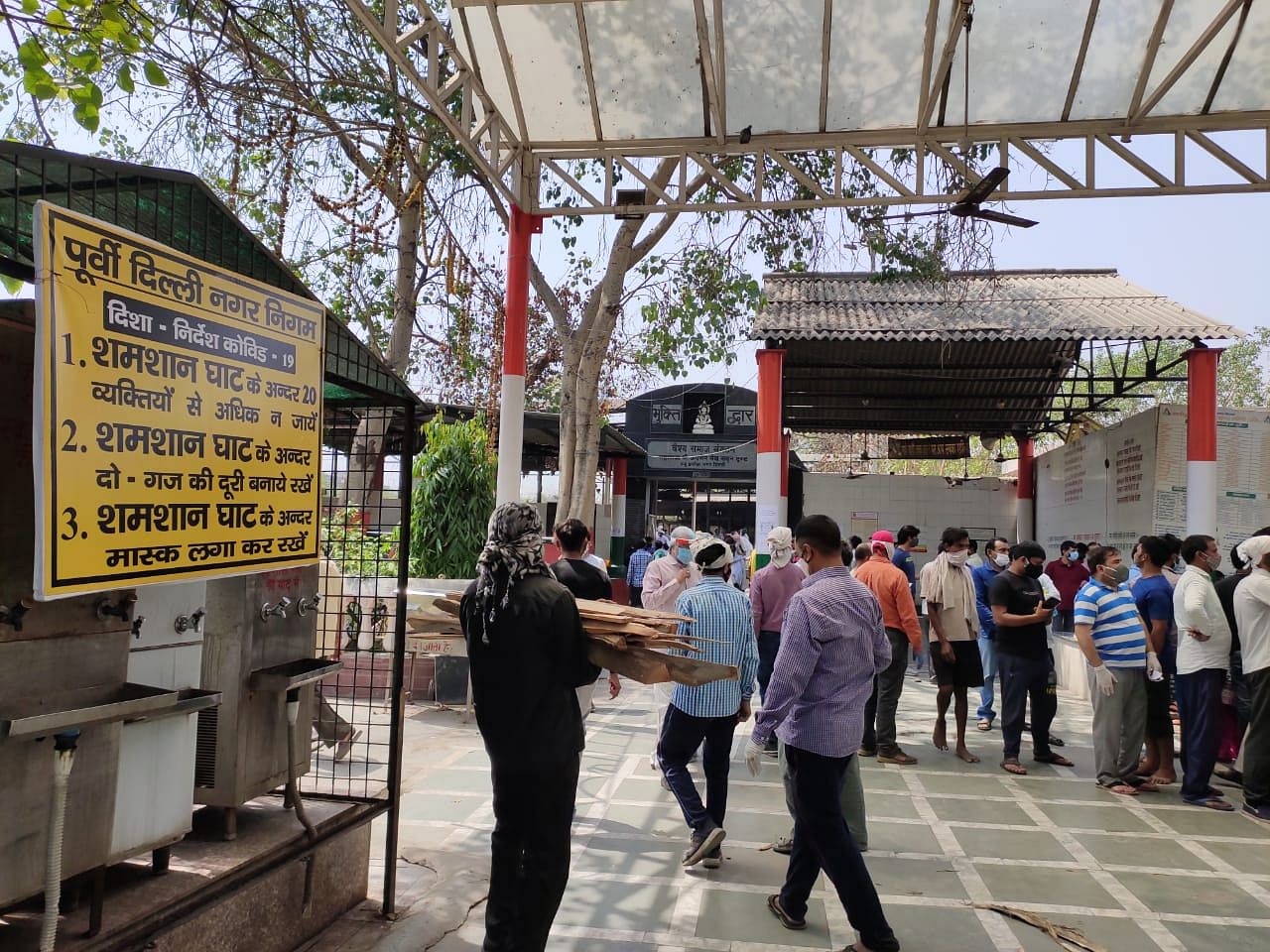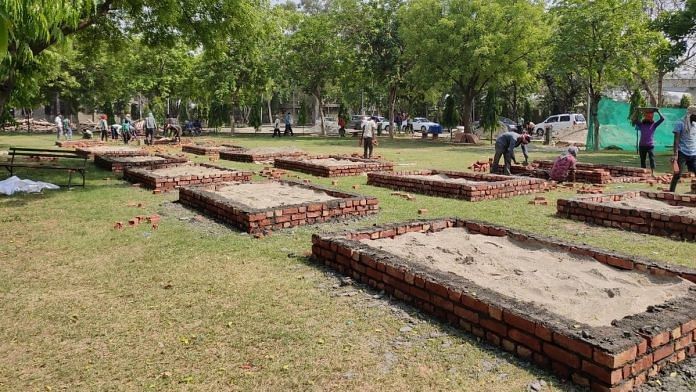New Delhi: At the Punjabi Bagh crematorium in the national capital, a blind man with greying hair, accompanied by his wife and daughter, walked up to the crematorium in-charge at around 4 pm Tuesday. With hands folded, he begged, “Please. I’m a blind man. Please have mercy on me and give me space to cremate my father. It’s been hours since he died, no one has given us a space. Please let me cremate my father.”
Mukesh, the in-charge, was surrounded by families seeking to register their deceased kin. He turned to the man with folded hands and said, before walking away, “Sir, I cannot help you. We are full to the brim. We don’t have space. Please go elsewhere.”
Before leaving to follow Mukesh, the man’s daughter told ThePrint, “My grandfather died at 7 am today at home. He was a Covid-19 positive patient. It’s now nearly 4 in the evening, and his body has been decomposing in the heat. We don’t know what to do.”
Around 30 km away, in Ghazipur crematorium, the smell of burning flesh rose from the flames and hung in the air. Over 40 people were being cremated at once, several of them on temporary platforms that have been constructed in the parking lot.
A serpentine queue of people indicated there were dozens more bodies waiting for their last rites.
“We can’t burn one pyre at a time. If we burn one, the billows of smoke will engulf other pyres, and will render them useless. So we line up all the bodies, and burn them all at once. It’s the most efficient way to cremate the bodies and save time,” said Sunil Sharma, the in-charge at the facility.

At Sarai Kale Khan, a small crematorium that had a capacity of 31 pyres is being expanded to accommodate over 100 bodies at a time. On Tuesday, 24 new platforms were finished and another 24 are expected to come up by the end of the week.
Delhi is in the throes of a third wave of Covid-19 cases, and its crematoria have been bursting at the seams trying to accommodate the deluge of bodies coming from homes and hospitals.
On Wednesday, the city recorded 25,986 fresh cases and 368 deaths. A day before, it registered 381 deaths — the highest single-day toll so far.
But crematoria and burial grounds must make space for Covid, non-Covid, and Covid suspected deaths, which pushes the number of bodies many times higher. The government is doing all that it can to make space — including converting a pet crematorium for human use.

“Last year, the South Delhi Municipal Corporation (SDMC) standing committee had approved the establishment of an animal crematorium in Dwarka. The project was put on hold during the pandemic, but things have become so grave that now we have orders to use this place for Covid funerals,” an SDMC official told ThePrint on condition of anonymity.
“It will become operational in the next few days, and it’s being kept as a reserve facility, just in case,” he added.
Also read: This Shaheen Bagh shop is supplying oxygen to Delhi’s gasping patients
‘Never seen this in my life’
Before the pandemic, 1,45,284 people had died in Delhi in 2019, according to the Delhi Directorate of Economics and Statistics. This averages about 398 deaths per day.
For a week now, Delhi has attributed 300 or more deaths in the city to Covid. To add to this, suspected and non-Covid-19 deaths have surpassed the daily average of 2019, say workers at the crematoria and MCD officials.
“From 19 April to 28 April, there were 5,404 burials and cremations at the 28 sites open for Covid bodies. That averages 540 deaths a day. The highest number of cremations and burials we have seen in a single day ever was 703 on 28 April,” a senior MCD official told ThePrint.
“Only people who had tested positive and died after that are counted as Covid deaths. We count the rest as normal deaths, even if it includes Covid suspected bodies,” said Sunil Sharma of Ghazipur.
The crematorium, which has 38 permanent pyres, would burn 12 to 14 bodies a day before the pandemic. Now, it is burning over 100, only a fraction of which are counted as Covid deaths. On Tuesday, for example, 115 bodies were cremated, of which 36 were Covid certified patients.
“The rest have to be suspect. So many died at home, so many died without tests. What else could explain the jump in numbers — from 12 to 14 to over 70?” said Sunil. “In the 20 years that I’ve worked in this crematorium, I have never seen what we are seeing today. Before we could accommodate bodies easily. We never had to struggle this way.”
At Sarai Kale Khan, crematorium in-charge Sunil Kumar told ThePrint a similar story: “We had just 30 pyres, and we’re expanding capacity to accommodate 100. Before the pandemic, we would get 6-8 bodies a day. Now we’re getting between 50 and 60, 90 per cent of which are Covid or Covid suspects.”
Delhi has at least 53 crematoria, 28 of which are open for Covid bodies. This is up from 21 crematoria and burial grounds open for Covid patients two weeks ago. The rate at which the government has increased capacity at each of these crematoriums is indicative of how many more deaths the city is faced with, compared to normal circumstances.
“In all these years, we never fell short of space because the daily number of deaths was never so many,” said an EDMC official who works in the medical department. “The pyres that have been set up are temporary, and they will be taken down when deaths reduce.”
Also read: First MP oxygen plant should’ve been up by now. But it’s just a heap of sand and stones
Shortage of manpower and wood
Workers and priests at crematoria toil for 12 hours at a stretch to ensure bodies are cremated. In Sarai Kale Khan and Punjabi Bagh, workers have even collapsed from exhaustion.
“I ensure they get a two-hour break in the middle of the day. We couldn’t function otherwise,” Sunil Kumar said.

At Ghazipur, the funerals for over 100 bodies are managed by 18 people, some of whom work through the night to keep the fires going.
“I’ve slept for three hours. I worked through the night and got here first thing in the morning. In the two years that I’ve worked here, it has never been so bad,” said Amit Pandey, a priest at the Ghazipur crematorium.
An SDMC official said what made matters worse logistically was that hospitals released bodies to cremation grounds irregularly, and that bodies from hospitals weren’t going to their designated crematoria.
“The workers at the crematoriums are ready first thing in the morning, but hospitals don’t release bodies till much later, around 11 am. Instead of releasing bodies in a timely manner, hospitals release them in batches. This causes a massive rush,” the official said.
Wood too is having to be supplied in greater quantities. The SDMC is using approximately 1,000 quintals of wood a day, while the EDMC has asked the crematoria under its jurisdiction to use cow dung in case there’s a shortage.
“If the deaths continue to come at the rate we are seeing, we will have a shortage of wood in 9-10 days, because neighbouring states are facing the same issue, too,” said the SDMC official quoted above.
(Edited by Amit Upadhyaya)
Also read: Not all doctors think putting medical, nursing students on Covid duty is practical. Here’s why







I have been reading reports of covid patients unable to find a place in hospitals. Why hasnt the Indian government ordered the military to construct super (temporary) hospitals ? They were set up in many countries last year (China, the US) why not in India ?>
It looks like Jyoti Malhotra has several of her reporters on crematorium porn production duty.
Mind boggling tragedy. Needless. heart goes out to survivors of the dead.